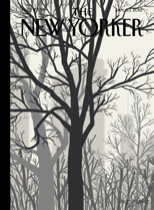>
January 23, 2012: “Labyrinth” by Roberto Bolaño
The Q&A with Barbara Eppler, Bolaño’s first American Publisher, is interesting, but of no help with this story, which I think I love. I say I think I love it because I don’t know that I have the energy to unpack it to see what’s there. If there’s nothing underneath the dazzling language and the manipulation of time, then I might like it less.
The story is based on a picture, and that picture appears to be the one in the magazine illustrating the story—take a look at it as you read the description of the people he names. I’ve reproduced it here, although when I read the story on my Kindle I hadn’t yet seen it. He’s describing this table and these people in great detail, whose actual names he uses, and then, I suppose—although I have no way of knowing—he is fabricating the rest: what they do with each other outside of the picture, what is happening beyond the picture’s frame, etc.
 What appeals to me here isn’t so much what happens, but the intersection of the real and the imagined, which includes a person who isn’t in the picture at all, and also the way in which the characters, as time passes, have lives outside of the picture but are also always frozen in the photograph.
What appeals to me here isn’t so much what happens, but the intersection of the real and the imagined, which includes a person who isn’t in the picture at all, and also the way in which the characters, as time passes, have lives outside of the picture but are also always frozen in the photograph. After the detailed description of the people in the photograph, about a third of the way into the story the author begins to imagine: “Let’s imagine J.-J. Goux, for example . . .” He has Goux leave the picture and walk down the street. Then he imagines that some of the people are looking at someone out of the frame, and imagines this might be “a young journalist from South America, no, from Central America.” He goes on to suggest that there may be something sinister about this journalist, that he’s bitter and will do some harm. It’s wonderfully imaginative, even if in the end it doesn’t produce any real action.
What do other people think? Or do you know something about the people the author has named here?


>So I read most of this story this morning on my kindle fire – picture looked great which I kept referring back to until I realized it wasn't of any help. I also think I loved this story, but I have to admit, it was very circuitous and made me actually dizzy! If I had to draw the picture out it would be less a labyrinth and more a spiral where in each turn around the main structure you go a little deeper than come back up and dive back down again.
>I just read the story and I too am a little in love. I'm sure I've never read anything quite like it. I read it in the actual magazine and so had the photo for reference the whole time. I think the people in the photo are real and that the menacing Central American stands in for the author who as once admiring and disparaging of their cozy writer's clique with it's abundance of turtlenecks.
>Am I the only one who read this story thinking it was like a writer describing his inspiration for a story [the photo] and then takeing us through his mindset as he develops the plotlines he envisions for the characters? Many writing classes teach you to use little notes to put on a story board to flesh out the narrative and each paragraph was to me like a little note on which he developed a back story and rationale for the character's action.
>I loved this story enough to look it up on the web to see what others are saying about it. This is what many of us do when we see people: imagine their inner lives, their relationships and conflicts. Bravo to Roberto Bolano who I'd never read anything by before. He has captured both the writer's imagination and the writer's world in this story. And like the photographer, he is on the outside looking in, with the rest of us. Loved it
>"Or do you know something about the people the author has named here?"
Hm, whom are you referring to? Not the Tel Quel group I suppose?